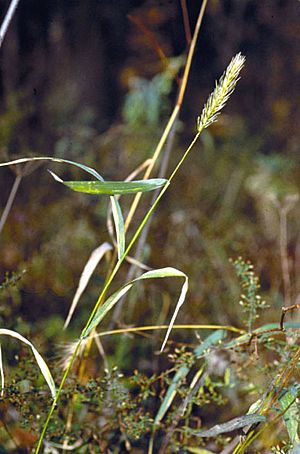Virginia wildrye facts for kids
Quick facts for kids Virginia wildrye |
|
|---|---|
 |
|
| Scientific classification | |
| Genus: |
Elymus
|
| Species: |
virginicus
|
Virginia wildrye, also known as Elymus virginicus, is a type of grass. It grows year after year, meaning it's a perennial. This grass grows in clumps, like a small bush, which is why it's called a bunchgrass. You can find it mainly in Virginia and the eastern parts of the United States. It's one of the few native grasses that grows well in cooler weather, even in places like East Texas.
Virginia wildrye is a good food source for animals like livestock. However, if animals eat too much of it without the grass having time to recover, there will be less of it. This grass spreads in two ways: by making seeds and by growing new shoots from its base, a process called tillering.
Sometimes, people might confuse Virginia wildrye with Canadian wildrye. Canadian wildrye is usually bigger and has longer awns, which are the bristle-like parts on the seed head. If this grass is used for hay, it's important to cut it early in the season. This helps avoid a problem called ergot contamination, which can make the hay unsafe.
Contents
What Does Virginia Wildrye Look Like?
Virginia wildrye is a native plant, meaning it naturally grows in the areas where it's found. It's a cool-season grass, so it grows best when the weather is not too hot.
Key Features of This Grass
- It grows as a perennial, coming back year after year.
- It forms clumps, making it a bunchgrass.
- The color can change, from green to a silvery-blue.
- It usually grows between 2 and 4 feet tall.
- Its seed head is dense and has medium-length awns.
- The seed head itself is typically 2 to 6 inches long.
How to Identify Virginia Wildrye
- The seed head stands straight up even when the plant is fully grown.
- It has a short, thin, and stiff part called a ligule where the leaf meets the stem.
- The seed head looks like wheat and has many awns.
- Its stems and leaves are smooth, with no hairs.
- The color can vary, from green to waxy blue-green or silver.
- It usually flowers between May and July.
Where Does Virginia Wildrye Grow?
Virginia wildrye can be found across the eastern two-thirds of the United States. It also grows in all the southern provinces of Canada. This grass usually prefers places that are a bit wetter than where Canadian wildrye grows. It can also handle more shade.
While it likes rich, fertile soils, Virginia wildrye is very adaptable. This means it can grow well in many different types of soil and conditions.
How Is Virginia Wildrye Used?
This versatile grass has several important uses:
- Pasture and Hay: It's a good food source for farm animals.
- Restoration: It helps bring back natural plant life in damaged areas.
- Erosion Control: Its roots help hold soil in place, preventing it from washing away.
- Wildlife Habitat: It provides a home and food for various animals.
- Buffer Strips: It can be planted in strips to protect water quality and create wildlife corridors.

